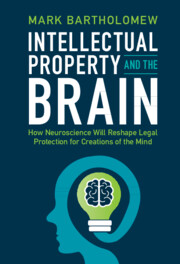 Intellectual Property and the Brain
Intellectual Property and the Brain Book contents
- Intellectual Property and the Brain
- Intellectual Property and the Brain
- Copyright page
- Contents
- List of Figures
- Acknowledgments
- Introduction
- Part I The Law and Neuroscience of Creative Activity
- 1 Copyright and Creativity
- 2 Inside the Design Process
- Part II Understanding Audiences for Art and Advertising
- Part III Using Neuroscience to Improve Intellectual Property Law
- Index
1 - Copyright and Creativity
from Part I - The Law and Neuroscience of Creative Activity
Published online by Cambridge University Press: 14 July 2022
- Intellectual Property and the Brain
- Intellectual Property and the Brain
- Copyright page
- Contents
- List of Figures
- Acknowledgments
- Introduction
- Part I The Law and Neuroscience of Creative Activity
- 1 Copyright and Creativity
- 2 Inside the Design Process
- Part II Understanding Audiences for Art and Advertising
- Part III Using Neuroscience to Improve Intellectual Property Law
- Index
Summary
Neuroscientific studies of the creative process reveal that artistic ingenuity is not the black box the law supposes it to be. These studies explode several popular myths about art and artists—myths that courts have used to justify their failure to truly interrogate creativity. The courts tend to believe in the creativity of novices, romanticizing the artistic potential of children and the mentally ill. Instead, the science reveals a strong correlation between expertise, learned skills, and creative output. Western societies assume that creativity arrives in a flash of insight, often when the artist is not even thinking about the project at hand; the truth is that creative breakthroughs take sustained effort and motivation. Rather than being incapable of outside understanding, various aspects of creative thought—including the generation of new visual imagery—can now be identified via changes in brain chemistry. The chapter uses copyright cases concerning a variety of works—from fine art to photography to Barbie dolls—to illustrate the flawed ways in which courts try to discern artistic creativity and how they might be reconceptualized in light of neuroscientific discoveries.
- Type
- Chapter
- Information
- Intellectual Property and the BrainHow Neuroscience Will Reshape Legal Protection for Creations of the Mind, pp. 15 - 37Publisher: Cambridge University PressPrint publication year: 2022


